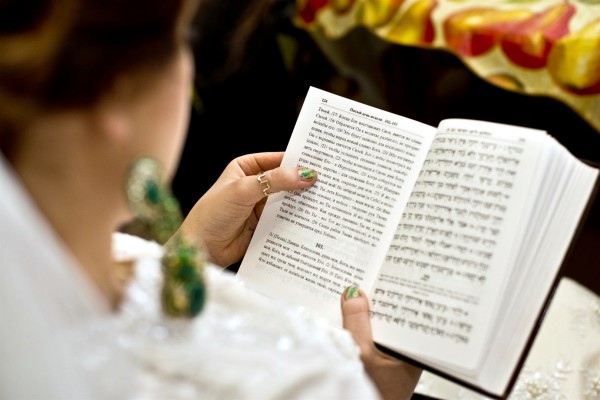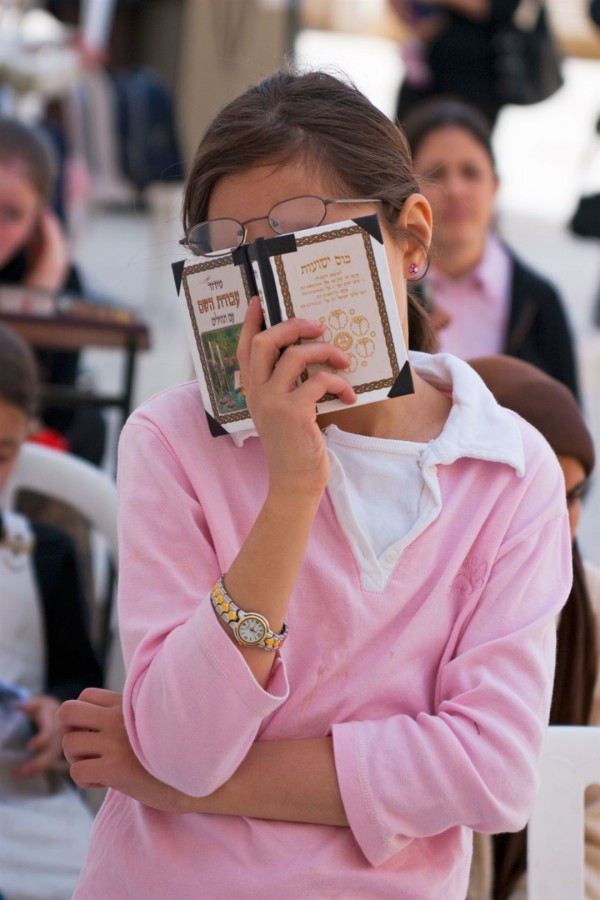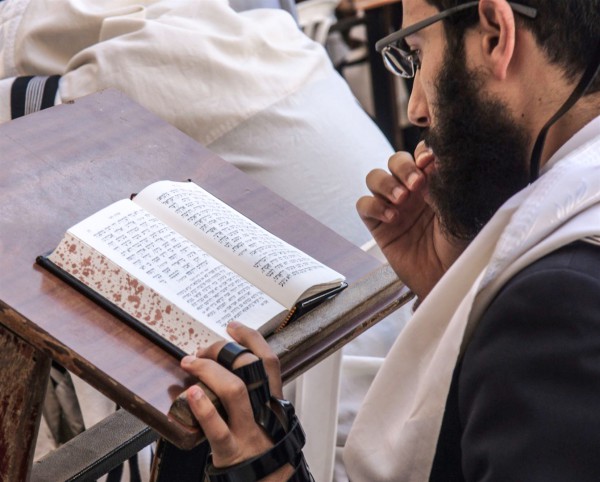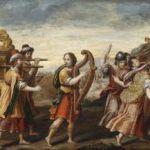“Answer me when I call to you, O my righteous God. Give me relief from my distress; be merciful to me and hear my prayer.” (Psalm 4:1)
The typical believer in God, whether he or she be a Jew or a Christian, may reach out to God in prayer (tefillah – תְּפִלָּה) at any time of the day. Within Judaism, as with other religions, a book of formal prayers has been designed to cover possibly every spiritual or material need. That book is called the Siddur, a Hebrew noun derived from seder (סדר), meaning order.
Traditionally, in Judaism, three prayer services are recited daily:
- Shacharit, from the shachar, meaning morning light
- Mincha, afternoon prayers named from the flour offerings in the Temple
- Maariv, from the word for nightfall.
In Judaism, prayer is regarded as our primary means for establishing a connection with God. It is described as Avodah Shebalev (service of the heart).
This attitude of service of the heart is sustained by Kavanat haLev (direction/ intent of the heart), a devotion to God that unites thinking and speaking.
In other words, prayers cannot be thoughtlessly repeated. We must pray with intention, devotion and direction.
The Siddur may be the most familiar book among Jewish people. In fact, for many generations, the Siddur was the first book that Jewish children learned to read.
This book is so loved that many learn to read the Hebrew prayers it contains without understanding the meaning of the words.
Moreover, the language of the Siddur influences everyday speech of Jews around the world.
A Messianic Prophecy Bible team member described his introduction to the Siddur:
“I remember the excitement I felt as a young child growing up in South Bend, Indiana, where I began to attend Hebrew school at the tender age of nine and learn about the Siddur and the daily prayers. There was a prayer for everything: eating a meal, having a snack, fruit, cookies, even for drinking water and washing my hands.
“Since I was not yet Bar Mitzvahed, I was not required to put on the tefillin or phylacteries that remind Jews to pray; however, I did recite the morning prayers.
“It was the Siddur that now framed the basic structure for my life.”
While his experience reflected a moderately conservative Jewish home, in a more Orthodox Hassidic home, children start Hebrew studies at a much earlier age, around three. They study six days a week.
The Relationship of Prayer
Traditionally and historically, formal prayers have been given primary importance in developing a relationship with God. However, the teachings of the Baal Shem Tov and the rise of Hassidic Judaism during the 18th century in Eastern Europe have given prominence to other heartfelt forms of worship.
The Hassidic movement, which is represented by the Chabad today, has always stressed a personal spiritual link with the Almighty that many times puts them in conflict with more conventional Jewish traditions.
Hassidism stresses a joyful relationship with God expressed through praise, prayer, and often dance. They realize that communication with God is not simply a matter of lip service, which is detestable to God.
“The Lord says: ‘These people come near to Me with their mouth and honor Me with their lips, but their hearts are far from Me. Their worship of Me is based on merely human rules they have been taught.'” (Isaiah 29:13)
Therefore, they place extreme importance on investing one’s heart and soul in this act.
Through prayer, our soul connects with the sovereign Lord of our lives and the universe; yet even in His awesome omnipotence, God has desired a personal relationship with us before He walked in the Garden with Adam and Eve.
We see the nature of this informality in the Hebrew language of the many blessings the Jewish people recite throughout the day. Every blessing includes the phrase:
“Barukh atah Ha-shem, Elokaynu, melekh ha-olam,”
“Blessed art thou [atah] Lord, our God, King of the Universe.”
In English, “thou” is used as an extremely formal second person pronoun reserved for kings and those with whom we have no right to claim any relationship with.
In stark contrast, the Hebrew word translated in English as thou is atah, the informal and very familiar second person “you” pronoun used when speaking to family and friends.
When we pray to God, therefore, we are praying to the sovereign King who desires to have an intimate relationship with us as our Father. We can also relate to Him as a friend through Yeshua HaMashiach, Jesus the Messiah.
“Greater love has no one than this: to lay down one’s life for one’s friends.” (John 15:13)
Jewish Prayer: What Do We Say?
The Chabad scholar Dovid Zaklikowski states that originally there were no set times for prayer nor any defined text.
Each person chose his or her own words to say while connecting to the Divine Presence through prayer.
We see this with the prayers of the prophets and kings. King David whose heart was devoted to pleasing the Lord, wrote his own prayers in the form of psalms.
In Psalm 25, for instance, David begins his prayer by declaring, “In you, LORD my God, I put my trust,” expressing his total reliance on the God of Abraham, Isaac and Jacob for his entire life sustenance.
In exchange for that trust, or perhaps because of it, David seeks protection, guidance, and forgiveness. He not only looks out for himself but for his entire nation, ending the psalm with, “May integrity and uprightness protect me, because my hope, LORD, is in you. Deliver Israel, O God, from all their troubles!”
Psalm 25 reveals standard elements of Jewish prayers: a declaration of trust in the one true God, gratitude for all that He has done for us, and individual and collective petitions.
The Development of Formal Group Prayer
Before the development of the synagogues and the use of the prayer book, group worship and prayer were carried out at the Temple.
Remnants of these Temple services can be seen in the Sabbath and Festival prayer services. On these days there is an added service that is linked to the sacrificial service of the Temple.
The destruction of the First Temple led to the exile of 70 years in Babylonia. Those born in this Diaspora did not know Hebrew; instead, many spoke a mixture of Babylonian, Persian, Greek, and other languages, making it impossible to formulate their own group prayers.
It was at this time that Ezra the Scribe, together with the Men of the Great Assembly (Sanhedrin), which included 120 prophets and sages, created a standard text for prayer in Hebrew.
Also at this time, the morning, afternoon, and evening daily prayers were established.
These three prayer services are still centered today on the Shemoneh Esrei (literally, eighteen), also called the Amidah (Standing), the quintessential Hebrew prayer. It is recited while standing and facing Jerusalem and the Aron Kodesh (Torah ark).
The Amidah are a series of 19 (formerly 18) blessings or benedictions. The first three praise and extol God, highlighting His power and holiness and appealing to Him as the protector of our forefathers.
Following the first three blessings are 13 individual and collective petitions. Prayers for personal needs include knowledge, repentance, forgiveness, redemption, health, and prosperity.
Petitions for the needs of the Jewish People include the return of the exiles, justice, victory, the reward of righteousness, the restoration of Jerusalem, and the coming of the Messiah.
The closing three petitions include the restoration of the Temple, thanksgiving, and a prayer for peace.
Some surmise that Yeshua’s “LORD’s prayer” is a concise restatement of the Amidah. This indicates that He was pointing to the practice of reciting the Amidah three times a day. We see this pattern of praying three times a day in Daniel’s life (Daniel 6:10) and King David’s life (Psalm 55:17).
During the Ten Days of Repentance (Days of Awe) between Rosh Hashanah and Yom Kippur, additional prayers for mercy and having one’s name inscribed in the Book of Life are inserted in the Amidah.

A Jewish man wears a tallit (prayer shawl) and tefillin (phylacteries) during morning prayer (Shacharit).
Expressing Our Souls Physically
Rabbi Daniel Kohn explains how motion helps us to symbolically enter the presence of God as we commune with Him.
For instance, the third prayer of the Amidah is a blessing of holiness. When we look to Scripture for an expression of such holiness, we see Isaiah’s magnificent vision of a chorus of angels worshipping God singing,
“Holy, holy, holy is the LORD Almighty; the whole earth is full of His glory.” (Isaiah 6:3)
Rabbi Kohn explains that our “human chorus of voices imitates the heavenly chorus, and thus, in a choreography designed to reflect angels, individuals rock up upon the balls of their feet three times, for each word ‘holy’ that is said, symbolizing the fluttering of the angels who recited this line of praise.” (My Jewish Learning)
As well, at the beginning of the Amidah, the group takes three steps back and three steps forward as a symbolic entrance into His presence. To exit His presence, at the end of the Amidah, the group takes three steps back, bows to both sides, and takes three steps forward.
In some congregations, as the High Priests’ role on Yom Kippur is recounted, the posture of kneeling on the ground and touching foreheads to the ground is adopted, humbly bowing before the King.
The prayer services on Yom Kippur are among the most moving times of prayer in the Hebrew calendar. The presence of God is very real and there is rawness in the way personal sins are corporately confessed.
In individual prayer, our bodies can further express how deeply our soul is afflicted and how intensely we desire a certain outcome. King David, for example, lay on the ground, fasting and making intense petitions to save the life of his son who was conceived from an adulteress affair with Bathsheba:
“David pleaded with God for the child. He fasted and spent the nights lying in sackcloth on the ground. The elders of his household stood beside him to get him up from the ground, but he refused, and he would not eat any food with them.” (2 Samuel 12:16–17)
The Shema, the Siddur, and the Mitzvah
Included in the morning and evening prayers are the Shema, which comprises three paragraphs from the Bible: Deuteronomy 6:4–9; 11:13–21; Numbers 15:37–41.
It begins with a defining statement that reminds us that we are building a relationship with the One True God: “Hear, O Israel! The LORD is our God, the LORD is one! You shall love the LORD your God with all your heart and with all your soul and with all your might. …” (Deuteronomy 6:4–9)
The Shema emphasizes love of God, Torah study, Divine reward and punishment, and the Exodus from Egypt. (Chabad)
This prayer is recited twice a day in fulfillment of the mitzvah (commandment) of praying morning and evening, a principle drawn from Deuteronomy 6:7.
“Impress them on your children. Talk about them when you sit at home and when you walk along the road, when you lie down and when you get up.” (Deuteronomy 6:7)
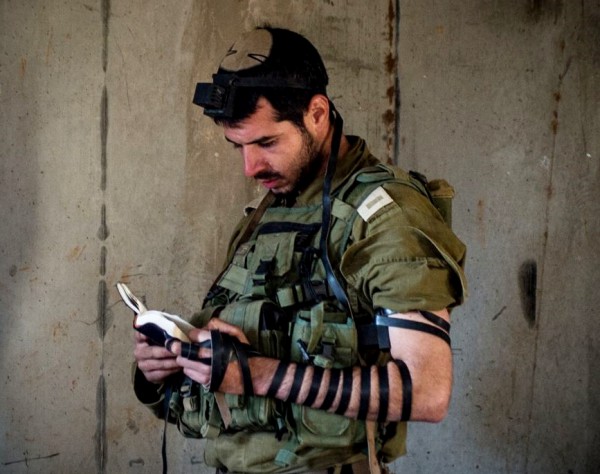
An Israeli soldiers wearing tefillin prays Shacharit (morning prayer). (IDF photo by Alexi Rosenfeld)
After the destruction of the Second Temple in 70 AD, the rabbis transferred what had once been worship at the Temple, complete with sacrificial offerings, to worship based on prayer.
At the Council of Jamnia in AD 70, it was decided the Amidah would substitute for the daily and festival animal sacrifices. Instead of sacrificing bulls and sheep, the utterance of one’s lips became an offering in keeping with the Prophet Hosea’s dictate:
“Take words with you and return to the LORD. Say to Him: ‘Forgive all our sins and receive us graciously, that we may offer the fruit of our lips.’” (Hosea 14:2)
Prayers were arranged to follow the order of sacrifices in the Temple.
These prayers were only recorded in writing after the Talmud (Oral Law) was written down. The general prayer book as we know it today is based on a Siddur compiled about 1,200 years ago by Amram ben Sheshna.
Group and Personal Prayer
It is understood that we cannot fulfill the command of the Shema to love God with all of our souls by simply reciting words from a book without sincerely seeking a relationship with God through those words.
We can remind ourselves with whom we are forming a relationship through the Yiddish word for “prayer” —daven, which may come from the same Latin root as the English word “divine.”
Moreover, the meaning of the Hebrew word for prayer, tefillah, comes from the root P-L-L or palal, which means to judge, clarify, differentiate. A related word, l’hitpalel, means to judge oneself.
As we connect with Adonai through prayer, we begin to see His ways more clearly. With that insight, we can better judge right from wrong in the world and within ourselves so that we can take corrective action to become holy as He is holy.
Therefore, as the prophets and kings did, we are encouraged to pray individually to God using our own words of praise, petition, and thanksgiving; nevertheless, tradition also encourages standardized communal prayer.
This is because it is believed that in the presence of several, God is more accessible and His presence is more evident. Also, by praying with others one benefits from the collective deeds and merits of the community.
Yeshua HaMashiach upheld the accessibility of God and the benefits of group prayer when he said, “Again, truly I tell you that if two of you on earth agree about anything they ask for, it will be done for them by my Father in heaven. For where two or three gather in my name, there am I with them.” (Matthew 18:19–20)
Because there is an emphasis in Jewish prayer “on responsibility for one another and our interlinked fates,” in order to conduct a synagogue service and engage in group prayer, a minimum quorum (a minyan) is required of ten men.
High Holy Day Prayer
On the High Holidays, additional prayers are designed to recognize the unique character of the day. One example of this is Hallel or Praise, which includes six psalms of celebration, nearly all of which begin with the word hallelu-yah, or praise God!
Some scholars believe that Psalms 113 through 118 were chanted by the Levitical Temple workers during the time of the Temple in Jerusalem.
Hallel is chanted immediately following the Amidah, preceding the Torah service on the festivals of Passover, Shavuot, and Sukkot.
On Shabbat, an additional service has been added, the Mussaf service, to account for the additional animal sacrifice of the Sabbath day. This service is also added to the holiday prayer books.
The machzor is a special prayer book used for the Jewish festivals but usually the term refers to the High Holy Day prayer book. The name comes from the Hebrew for cycle indicating that its use is a recurring annual event.
It takes the form of an expanded Siddur and is filled with special liturgical poetry and Biblical readings that fit Rosh Hashanah and Yom Kippur.
Some well-known prayers are included, such as Kol Nidrei, which is chanted the evening of Yom Kippur and which annuls all vows proceeding that day, and Avinu Malkenu (Our Father, Our King).
The Importance of Prayer
“Rejoice always, pray continually, give thanks in all circumstances; for this is God’s will for you in Christ Jesus.” (1 Thessalonians 5:16–18)
Some may say that there is no need to pray because God will do what God will do. This sentiment misses the whole purpose of prayer: it is not just about petitions and it is not just about worship and praise of our Sovereign, holy God and Father; it is about communion with Him.
Nevertheless, God has indeed changed the course of events at the request of individual prayer, such as with Abraham’s prayer to save Lot out of Sodom and Gomorrah, or Moses’ prayers to save the Israelites from total destruction, or Hezekiah’s prayer as he faced the wall in granting him 15 more years of life.
Yet, God still holds the right to implement His plan in His sovereign will.
Therefore, when God’s answer to David was “no,” he simply got up from the ground, washed and sat at the table to eat, explaining to his servants, “While the child was still alive, I fasted and wept. I thought, ‘Who knows? The LORD may be gracious to me and let the child live.’ But now that he is dead, why should I go on fasting? Can I bring him back again? I will go to him, but he will not return to me.” (2 Samuel 12: 22–23)
Our prayers cannot guarantee any outcome, but we will never know what our petitions could have resulted in if we do not pray.
And the more we familiarize ourselves with Scripture, the more we will understand His will and better pray that His will be done. Of course, the Jewish prayer book is quite instructive when it comes to this: it is full of moral instruction, ethical guidance, and our duties and responsibilities.

Jewish men recite prayers at the Western (Wailing) Wall in Jerusalem. The man wearing tefillin (phylacteries) is reading from a Siddur.
While we are instructed to pray continuously (not just three times a day) and can pray privately in our cars, in our workspace, anywhere at any time in any position, there are times when we should gather together to communion with Him in worship, prayer, and praise, as well as to agree in prayer for God’s will to be done.
Individually, as Believers in Yeshua as the Jewish Messiah, Jews and Gentiles have access to God as Father through Yeshua. We are all priests in a Kingdom where Yeshua sits as high priest next to Abba Father.
We can come to Him, and He assures us that if we ask anything in His name, which conforms to His will and desires, He will answer.
“Until now you have not asked for anything in my name. Ask and you will receive, and your joy will be complete. … The Father Himself loves you because you have loved Me and have believed that I came from God.” (John 16:24, 26)









